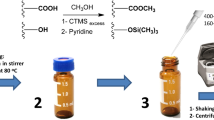Abstract
Colon cancer is one of the most reasons for cancer death worldwide. Thus, it is important to find new prognostic and diagnostic marker, as well as to throw light on the special metabolic pathways of colon cancer cells. This paper highlights for the first time some qualitative differences in the profiles of the volatile metabolites of colon cancer cell lines SW 480 (grade IV, Duke B) and SW 1116 (grade II, Duke A) among themselves and in comparison to the normal colon cell line NCM460, which are mostly represented by ketones and alcohols. These results, which were obtained by applying solid phase micro extraction (SPME) and combined gas chromatography/mass spectrometry (GC/MS), are consistent with Warburg’s hypothesis because the found reaction products may indicate that the cancer cells show the Crabtree’s effect. Furthermore, compounds like undecan-2-ol and pentadecan-2-one were associated for the first time with the human metabolism. In summary, these findings indicate that the metabolism of colon cancer cells differs extremely from the metabolism of healthy cells and it changes during the progress of the disease. Compounds that are present in the breath, the blood and the tissue of patients represent the differences and they can serve as new biomarker for colon cancer in future.


Similar content being viewed by others
References
Bosron W.F., Li T.K., Dafeldecker W.P., Vallee B.L. (1979). Human liver pi-alcohol dehydrogenase: kinetic and molecular properties. Biochemistry 6:1101–1105
Chen G., Banoglu E., Duffel M.W. (1996). Influence of substrate structure on the catalytic efficiency of hydroxysteroid sulfotransferase STa in the sulfation of alcohols. Chem. Res. Toxicol. 9:67–74
Chou C.F., Lai C.L., Chang Y., Cuester G., Yin S.J. (2002). Kinetic mechanism of human class IV alcohol dehydrogenase functioning as retinol dehydrogenase. J. Biol. Chem. 277:25209–25216
Forrest G.L., Gonzalez B. (2000). Carbonyl reductase. Chem. Biol. Interact. 129(1–2):21–40
Klyosov A.A. (1996). Kinetics and specifity of human liver aldehyde dehydrogenases toward aliphatic, aromatic, and fused polycyclic aldehydes. Biochemistry 35:4457–4467
Larroy C., Fernandesz M.R., Gonzalez E., Pares X., Biosca J.A. (2002). Characterization of the Saccharomyces cervisiae YMR318C (ADH6) gene product as a broad specificity NADPH-dependent alcohol dehydrogenase: relevance in aldehyde reduction. Biochem. J. 361:163–172
Lee T. (1979). Characterization of fatty alcohol: NAD+ oxidoreductase from rat liver. J. Biol. Chem. 254:2892–2896
Leibovitz A., Stinson J.C., McCombs W.B., McCoy C.E., Mazur K.C., Mabry N.D. (1976). Classification of human colorectal adenocarcinoma cell line. Cancer Res. 36:4562–4569
Moyer M.P., Manzano L.A., Merriman R.L., Stauffer J.S., Tanzer L.R. (1996). NCM460, a normal human colon mucosal epithelial cell line. In Vitro Cell. Dev. Biol. Anim. 32:315–317
Nicholson J.K., Wilson I.D. (2003). Understanding global systems biology: metabonomics and the continuum of metabolism. Nat. Rev. Drug Discov. 8:668–676
Oritani H., Deyashiki Y., Nakayama T., Hara A., Sawada H., Matsuura K., Bunai Y., Ohya I. (1992). Purification and characterization of pig lung carbonyl reductase. Arch. Biochem. Biophys. 292:539–547
Roessner U., Wagner C., Kopka J., Trethewey R.N., Willmitzer L.(2000). Simultaneous analysis of metabolites in potato tuber by gas chromatography-mass spectrometry. Plant J. 23:31–142
Sakai K., Hamada N., Watanabe Y. (1985). Purification and properties of secondary alcohol oxidase with an acidic isoelectric point. Agric. Biol. Chem. 49:817–825
Schmied B.M., Ulrich A., Matsuzaki H., Batra S.K., Pour P.M. (2000). Maintenance of human islets in long-term culture. Differentiation 66:173–180
Schomburg I., Hofmann O., Bänsch C., Chang A., Schomburg D. (2000). Enzyme data and metabolic information: BRENDA, a resource for research biology, biochemistry and medicine. Gene Funct. Dis. 3, 4:109–118
Schulz T.J., Thierbach R., Voigt A., Drewes G., Mietzner B., Steinberg P., Pfeiffer A.F.H., Ristow M. (2006). Induction of oxidative metabolism by mitochondrial frataxin inhibits cancer growth: Otto Warburg revisited. J. Biol. Chem. 281(2):977–981
Shockcor J.P., Unger S.E., Wilson I.D., Foxall P.J.D., Nicholson J.K., Lindon J.C. (1996). Combined HPLC, NMR spectroscopy, and ion-trap mass spectrometry with application to the detection and characterization of xenobiotic and endogenous metabolites in human urine. Anal. Chem. 68:4431–4435
Villas-Bôas S.G., Mas S., Åkesson S.M., Smedsgaard J., Nielsen J. (2005). Mass spectrometry in metabolome analysis. Mass Spectrom. Rev. 24:613–646
Wermuth B., Munch J.D., von Wartburg J.P. (1977). Purification and properties of NADPH-dependent aldehyde reductase from human liver. J. Biol. Chem. 252(11):3821–3828
Acknowledgments
The authors thank Rita Fobbe, Luzie Seifert and Helke Reinhardt for technical assistance. The financial support by the Ministerium für Innovation, Wissenschaft, Forschung und Technologie des Landes Nordrhein-Westfalen and by the Bundesministerium für Bildung und Forschung is gratefully acknowledged.
Author information
Authors and Affiliations
Corresponding author
Rights and permissions
About this article
Cite this article
Zimmermann, D., Hartmann, M., Moyer, M.P. et al. Determination of volatile products of human colon cell line metabolism by GC/MS analysis. Metabolomics 3, 13–17 (2007). https://doi.org/10.1007/s11306-006-0038-y
Received:
Accepted:
Published:
Issue Date:
DOI: https://doi.org/10.1007/s11306-006-0038-y




